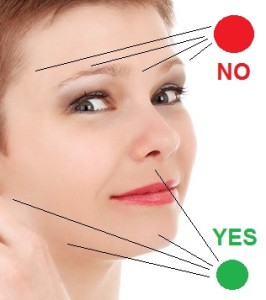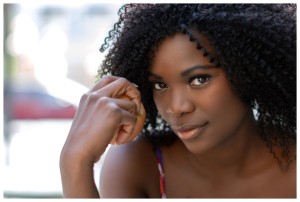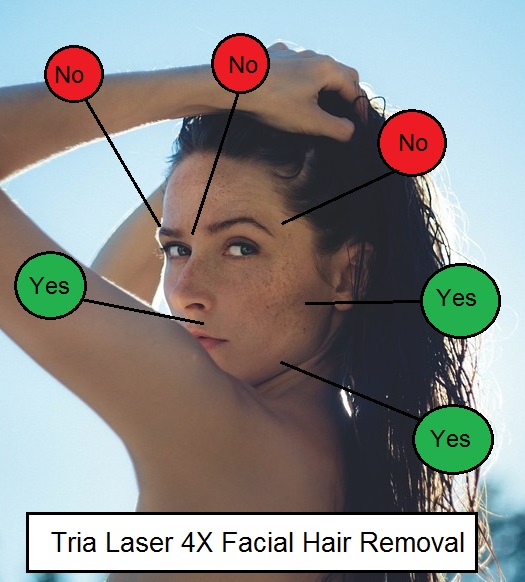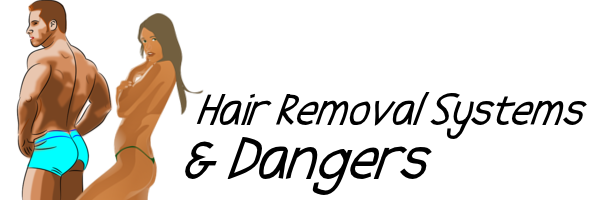Is Tria Laser Safe On Face
 [Affiliate disclosure, all links to amazon are affiliate links] One of the main reasons people buy a home laser hair removal system, is to remove unwanted facial hair. Since TRIA laser is so popular, many wonder is TRIA laser safe to be used on the face?
[Affiliate disclosure, all links to amazon are affiliate links] One of the main reasons people buy a home laser hair removal system, is to remove unwanted facial hair. Since TRIA laser is so popular, many wonder is TRIA laser safe to be used on the face?
In this review we will cover the Tria safety pros and cons and will focus on the issues related to safety when planning to treat facial skin. Getting a laser device so close to the eyes, has some points worth to emphasis, so you can do a safe and effective procedure.
Note the TRIA is not approved to be used on the face by everyone, so read below to see if you can.
The TRIA Is Safe For Most People
Let’s begin with the basics, TRIA laser is a safe machine! It has the necessary FDA approval to be used at home safely and it has some of the best safety features which outrank even some of the advanced IPL home devices which competes with it.
The TRIA was one of the first laser system which got FDA approval to be marketed for home use. In order to get the approval for a laser device to be utilized by thousands of people daily all over the world, it had to develop top notch safety features to ensure all those men and women using it are safe, and can not get injured even accidentally by their device.
A few years ago, the TRIA laser was not approved for facial hair removal. This had been changed over the years as other devices got approved for facial hair removal and the Tria beauty. The new 4x (fourth generation) Tria is cleared for treating facial hair reduction from very specific locations and not by everyone.
The Tria laser targets the dark melanin in the hair, and heats it. This causes the hair to warm up and burn in an instant zap. For this procedure to work, the skin (the background) has to be ‘white’ and the hair need to be dark.
Who Can Use TRIA Safely On Face
First the user has to be the right candidate to use the TRIA laser safely. This means they have to be within the right range of possible skin tones and with the right hair color as well. You can see the TRIA skin chart below, this applies for the facial skin as well:
 If your skin is fair color, and the hair you intent to remove is dark, then you are the right candidate for the Tria Beauty Laxer 4X.
If your skin is fair color, and the hair you intent to remove is dark, then you are the right candidate for the Tria Beauty Laxer 4X.
You can use the TRIA safely on your face according to the guiding points below. Click below to find out the latest price and current discounts at Amazon for the Tria 4X laser.
Shop for TRIA laser at Amazon – Read latest customers reviews HERE
Who Can Not Use TRIA On Face?
If your skin is dark, the laser will heat the skin and not the hair. If the hair color is not dark (gray, white, red, blond) the laser can not heat it. Most people have a darker facial skin due to sun exposure and natural tanning, as compared to underarms or abdominal.
 If your skin is as dark as the two examples on the right side of the chart above, then the TRIA is not safe for you. The laser emitted would heat the skin and can cause skin burns, and side effects.
If your skin is as dark as the two examples on the right side of the chart above, then the TRIA is not safe for you. The laser emitted would heat the skin and can cause skin burns, and side effects.
For most women the facial hair is a fuzz of fair hairs, which are not dark. In this case the laser has nothing to target… and the hair warming process will not occur.
Men Can Not Use TRIA on Face
 Many men choose the TRIA to reduce body hair from all the unwanted areas, abdominal, chest, neck, shoulders, arms, legs, thighs and pubic hair. Some even go further and remove hair from private parts.
Many men choose the TRIA to reduce body hair from all the unwanted areas, abdominal, chest, neck, shoulders, arms, legs, thighs and pubic hair. Some even go further and remove hair from private parts.
The TRIA can be used safely by men only to remove collar neck hair and downward! This would include removing hair from shoulders, and upper back. The male hair growth on face is not like the rest of the body.
Body hair for women and men is vellus hair, which is thinner and more delicate. Men have a different kind of hair growth over face and pubic which is andogenic hair, and thus should not be treated with laser. Wikipedia has this about androgenic hair growth:
Body hair, or androgenic hair, is the terminal hair that develops on the human body during and after puberty. It is differentiated from the head hair and less visible vellus hair, which are much finer and lighter in color.
The growth of androgenic hair is related to the level of androgens (often referred to as male hormones; due to the production levels in males being higher on average, but it is actually present in both sexes, and therefore is a unisex hormone) in the individual.
So even males who are the right candidates for using Tria, can not use it over the face.
Where Can Tria Be Used On Face?
For women who have the right skin and hair contrast, the TRIA can be used only from the cheekbones and downward. This is extremely important to follow this rule, as getting laser too close to the eyes can be dangerous.
You can use TRIA to treat hair growth on sideburns, cheeks and chin. Upper lip can be done too, but with attention not to pulse laser on the lips themselves. You should absolutely avoid using the TRIA for eyebrows contouring, between nasal bridge brows and sides of temples or anywhere near the eyes. See the diagram below to learn which areas are no-no and which are OK.
 If you follow these safety rules you can prevent all of the eye accidents.
If you follow these safety rules you can prevent all of the eye accidents.
If you haven’t bought a TRIA laser yet, and you have the right skin color, you should by know learned that you can use it safely on your face to get rid of unwanted facial hair. Click below to buy your home hair reduction kit, or read what others are saying about it.
Check the latest ratings what other are saying about the TRIA laser.
More Tips For Safe Facial Hair Removal
 When treating the face use a mirror, and use laser safety goggles.
When treating the face use a mirror, and use laser safety goggles.
Make sure you buy googles which cover the TRIA laser wavelength which is 810 nano-meter, you can find such laser safety goggles here.
Use the lowest laser setting when beginning to treat the face. The skin is more sensitive and delicate, you do not want to use the ‘big canons’ on such areas.
Use ice packs to cool the skin before you treat it. If you feel unusual pain or discomfort, stop and check.
Make sure not to zap over tattoos or any dark spots, as the laser can zap the flesh instead of the hair. Cover dark spots with white makeup pencil or a tiny white masking tape.
Check the latest reviews and order the TRIA Laser from Amazon.
Please read the TRIA beauty user manual guide to be well aware and informed about the aspects of each session.
